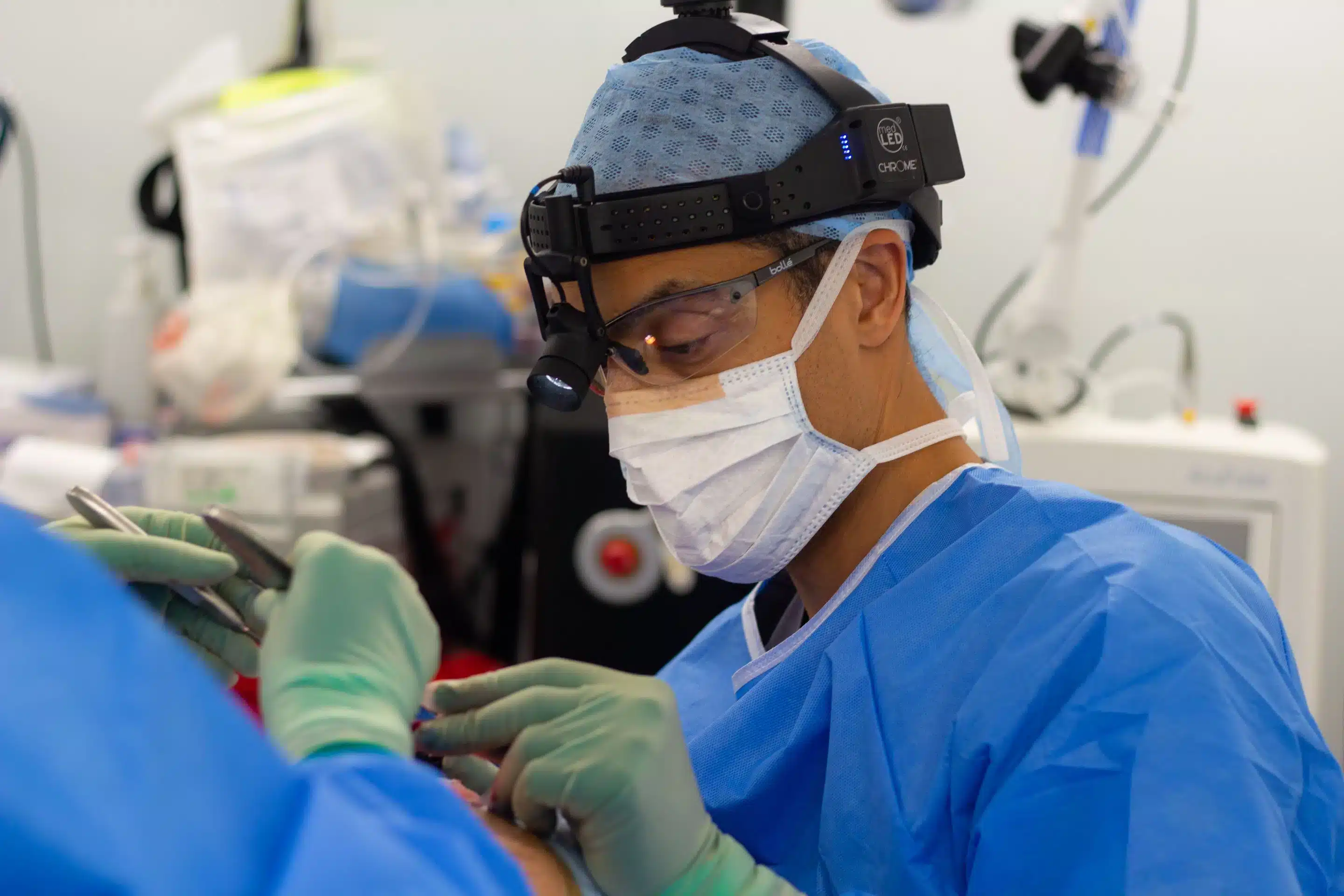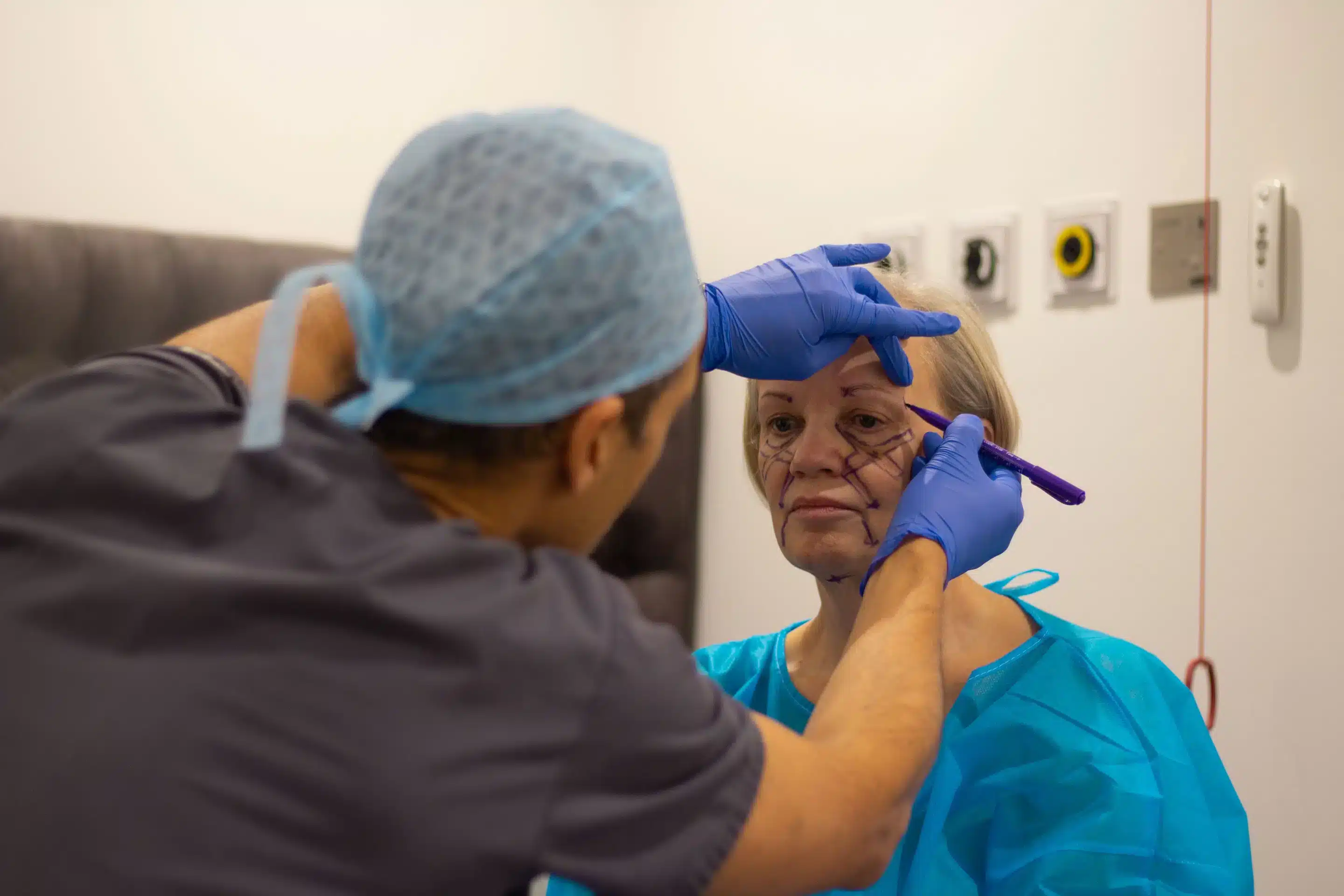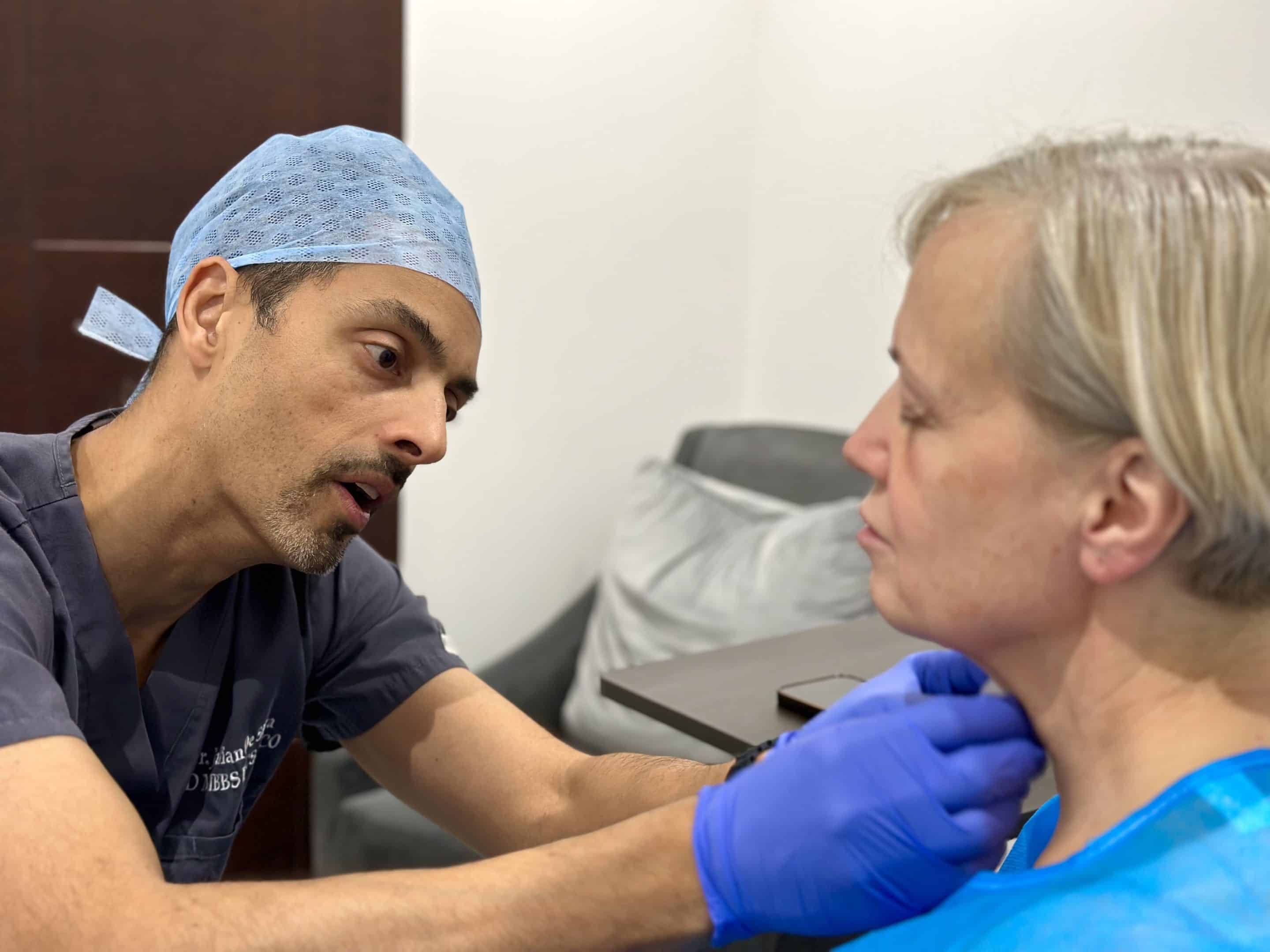
Decreased collagen production and hyaluronic acid levels cause jowls.
As you become older, you tend to lose definition around your jawline. The supporting components that keep your features youthful, like elastin and collagen, begin to deplete.
You might lose fat in the cheeks and temples and have excess or saggy skin. These lead to your chin and neck losing shape. On top of that, your skin becomes drier and thinner as you age. This makes it less robust and more susceptible to the forces of gravity.
As a result, loose skin around your chin and jawline can form. This generates jowls that age your entire appearance.
But how do you get rid of jowls? Can you permanently eliminate them?
In this article, I will talk about how you can get rid of jowls and prevent future sagging skin. I will also answer the most common questions about jowls.
Can You Reverse Sagging Skin and Jowls?

Jowls are less pronounced in people who have thicker skin, but they become more noticeable as one age.
Yes, you can reverse sagging jowls. While jowls are a natural sign of ageing, you can reverse them through many treatments.
For one, injectable solutions such as dermal fillers are great for restoring your face volume. Ultrasonic treatments such as Ultherapy are also helpful for stimulating the creation of more collagen. This immediately lessens the sagging effect of jowls.
Radiofrequency (RF) skin treatments can also recontour, smooth, tighten, and lift the skin on your jaw and chin areas. Each treatment has its own distinct advantages, and our professionals can assist you in selecting the best process for your specific skin needs.
However, if you want a permanent fix for pronounced jowls, surgery performed by board-certified plastic surgeons like Dr. Julian De Silva, M.B.B.D, MD is the right way to go.
Will Losing Weight Get Rid of Jowls and Saggy Skin?

Unfortunately, weight loss isn’t the most effective way to eliminate frustrating jowls.
Losing weight won’t help eliminate droopy jowls. In fact, for many, especially individuals with older skin, losing lots of weight might make the jowls stand out even more. That’s because weight loss can actually highlight them to begin with.
However, according to some studies, facial exercises and exercise, in general, can help reduce the look and severity of droopy skin and jowls. They do this by improving the ability of the facial, jaw, and neck muscles to keep their form.
The majority of prescribed exercises should be performed one after the other to ensure that the face muscles are exercised evenly. Each exercise should be held for 10 to 20 seconds before being released.
The following are some common facial exercises that may help improve jowls:
- Yawning and opening the mouth as widely as possible, then gently shutting it without allowing the teeth to contact.
- Outward puckering of the lips This practice is most effective when performed laying down and drawing the sides of the lips downwards with the fingers.
- Blowing up the cheeks as far as possible.
- Chewing with the head slightly inclined up.
- Grinning as wide as possible, then tilting the head up and down gently.
- Tilting the head up and placing the lower lip on the top lip.
- Lying down flat, curving the neck in towards the chest, and pushing the tongue on the roof of the mouth.
- Humming while pressing the tongue on the roof of the mouth.

Facial exercises are not statistically proven to treat jowls.
However, all existing research on the effect of facial exercises on treating jowls is not enough to pull out statistical evidence. Hence, only a treatment plan that includes one or more procedures like jowl soft tissue reduction and plastic surgery ensures results.
This should not stop you from exercising your body and facial muscles though. Exercise greatly improves various elements that contribute to your skin health. This may help lessen the age at which jowls form, as well as their severity.
Any repetitive facial habits that evenly activate or stretch the face muscles without overusing them may also aid in the reduction of jowls.
Jowls: Why It Happens and What You Can Do

Bad lifestyle choices can cause jowls and saggy skin.
Jowls are drooping or excess skin on the neck, directly below the jawline and chin. Almost everyone gets jowls as they become older, mainly because their skin loses elasticity.
Several causes, including genetics, sun damage or UV rays, lifestyle factors, and lost volume can contribute to more prominent jowls.
Though various variables are known to enhance the frequency and severity of jowls, age is the root reason.
This is because the skin begins to lose some of the substances that help it maintain its form as it ages. These substances include fat and connective tissue proteins like elastin.
The skin also becomes drier and thinner, making it more difficult to keep its shape. As the skin loses its elasticity and volume, it becomes more sensitive to gravity.
Sagging skin around the lips and cheeks migrates to the chin and jawline, resulting in jowls and a sagging jawline.
The following are risk factors for jowls:
- Sunburn history
- Excessive or chronic alcohol consumption
- Smoking
- Dehydration, whether chronic or severe
- Long-term or severe stress
- Diets deficient in antioxidants, good fats, and other vital elements
- Frowning, chewing gum, chatting on the phone, and other behaviors or expressions that use the cheek, mouth, and jaw muscles.
- Skin allergies
- A lack of skin hygiene
- Little to no physical activity
- Poor lifestyle choices
How to Eliminate Jowls Fast: Treatment and Prevention

A treatment plan for jowls can include more than one procedure.
1. Facelift and Neck Lift
If you want to get rid of fat and tighten your face and neck, then a neck lift is for you. In most neck lifts, the incisions are made in front of and behind the ear, reaching into the hairline.
In some circumstances, a complete neck lift and facelift may be necessary to enhance your look. This plastic surgery eliminates fat, makes your skin tight, enhances your cheek muscles, and repositions skin on the lower half of your face so that your neck and face look the same.
While these procedures are promising, there are different type of facelift that can be tailored to your individual needs. For most patients a natural vertical lift, restoring the areas that have dropped to their original position is best (modified deep plane facelift), for some patients less is more (pony tail facelift, mini facelift).
2. Fat reduction & Chin Implant
For younger patients with fullness under the neck and jaw line, another way to get rid of fuller neck is through fat reduction with or without a chin implant.
During this treatment, the surgeon will use a microcannula to remove fat from your chin region. They will also restructure the skin and jawline to avoid sagging in the future. Combined with bringing the chin forward this can work well for younger patients with good skin elasticity.
Fat reduction can also be done with radio frequency or laser therapy to ensure that your skin remains tight and smooth. Dr De Silva frequently tightens the neck muscle (platysma) to reduce seeing a band in the neck that commonly comes with age. Although this is a universal aspect of ageing these stitches can help hide this change.
3. Radiofrequency Jawline Tightening
This technique tightens the skin around your neck and chin using heat and radiofrequency energy from a gadget.
It may be repeated several times to guarantee that your skin remains tight. The recovery period is short, and the treatment may be completed in a single day.
4. Dermal Fillers

Dermal fillers can help treat those stubborn jowls of yours.
Dermal fillers are formed of a substance known as hyaluronic acid. In addition, dermal fillers are filler injections placed into the neck and chin to fill up jowls and make them appear less sagging.
Some dermal jawline fillers also stimulate your body’s production of collagen, allowing you to keep your skin tight. Although most fillers are soft and made of a gel called hyaluronic acid. They can be mixed with a calcium filler that will give a stronger more defined and shaped jaw line.
5. Ultrasound
Ultherapy is the use of ultrasonic therapy to encourage long-term collagen formation in the skin’s deep layers.
It typically takes one session, and patients are able to resume their normal activities immediately following the operation.
Several months following treatment, most patients report a continuous improvement in skin tightness and stiffness.
This is a non-surgical treatment and often the results are relatively mild and conservative, not suitable for patients wanting marked change and the results are three to six months after receiving ultrasound therapy.
6. Radiotherapy
Radiotherapy employs intense, radiating heat to promote collagen and elastin fibre bundles around 2 millimeters beneath the skin’s surface. As a result, the bundles recoil and the skin tightens.
Radiotherapy also increases protein formation by deceiving the body into believing connective tissues are injured.
For best outcomes, many patients need to repeat treatments a few times a year. Pelleve is the most commonly used brand name for jowl radiation.
What Can I Do to Reduce My Risk?

You can prevent jowls and reduce risk by avoiding smoking.
Here are things you can do to reduce the risks associated with procedures involving the jowl area:
- Avoid smoking
Cigarettes and other kinds of tobacco contain toxins that can harm your skin. - Limit your exposure to the sun
Before going out for the day, always apply sunscreen with at least SPF 30 on your face and neck. Make it a part of your morning routine to protect your skin from UV rays. - Limit your screen time
When using a computer or phone, try to maintain your head in a natural, comfortable position. Avoid bunching up or stretching out your neck skin. You may also safeguard your muscles by taking a 10-minute break for every hour spent on the computer.
What if I Already Have Jowls?

If you have jowls and a sagging chin area, know that you have many treatment options.
There are various techniques for correcting drooping jowls or making them seem less saggy or droopy. Neck lifts, for example, can tighten your skin and make it appear less saggy.
Non-surgical therapies such as thermage, lasers, and fillers can alter the collagen composition of your skin. To conceal empty regions around the jowls, fillers might be employed.
When you go out, you can also disguise your jowls with clothes and cosmetics.
What Causes Jowls?

Jowls are caused by the same factors that cause wrinkles.
Here are the common causes of jowls:
1. Loss of Elastin and Collagen
The skin on your cheeks and the skin below your jaw loses a lot of elastin and collagen as time passes by. Collagen is a protein that builds up your body’s connective tissue. Elastin is another substance that gives your skin the ability to go back to its original form after being stretched.
2. Genetics
Your genes can also influence whether you acquire jowls and how visible they become over time. For one, you are more prone to get jowls if either of your parents has them. If you have thin skin or a lack of collagen and elastin in your skin, you may develop jowls at a young age as well. Jowls can appear as early as your twenties or thirties.
3. Facial Expressions
Making specific facial expressions often might stretch out your face or neck skin.
4. Sun exposure
Overexposure to ultraviolet (UV) radiation in sunlight might harm your skin. As a result, your skin may sag sooner.
5. Smoking
Cigarette nicotine and other substances can harm your collagen and elastin levels. On top of that, smoking can cause your blood vessels to constrict. This reduces blood circulation and inhibits your skin from receiving essential nutrients such as vitamin A.
6. Using computers or phones
Long durations of computer use or staring down at a smartphone can cause your neck area to lose its suppleness. The term “tech neck” refers to these jowls.
What Are the Best Procedures for Jowls?

The best treatment for jowls include a facelift and neck lift.
The best procedures for sagging jowls are undoubtedly a neck lift and full facelift.
For one, a neck lift and full facelift are permanent fixes. This means that you only have to get them once.
In fact, many of my patients who get these procedures enjoy the results for a lifetime.
Visit Dr. Julian de Silva – Facelift, London
If you’re dissatisfied with your jowls, you have numerous alternatives for treating them.
Talk to me, Dr. Julian De Silva, an experienced and qualified plastic surgeon about the best choice. Contact us to book a consultation with Dr. De Silva now! As an alternative, you may visit our Harley Street clinic, the Centre for Advanced Facial Cosmetic & Plastic Surgery.





